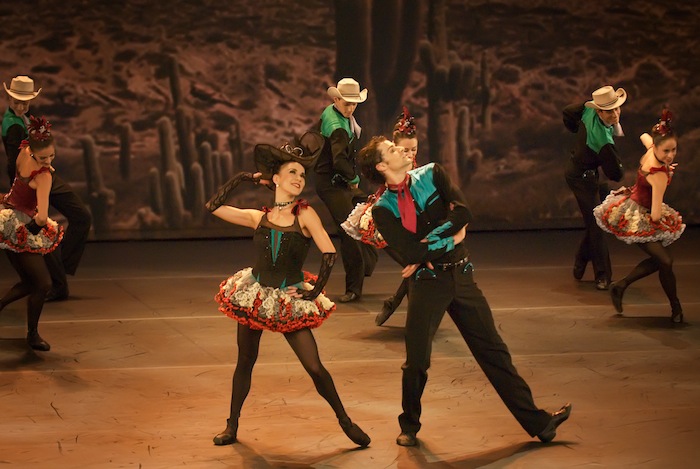
Miami City Ballet ensemble in "Western Symphony." Photo: Kyle Froman.
A varied program focusing on the choreography of George Balanchine and Twyla Tharp opened the new year for Miami City Ballet Friday night at the Arsht Center. Four highly contrasted works found the company dancing in high gear with not a weak link to be found from principals to the highly disciplined corps de ballet.
La Sonnambula is one of Balanchine’s most unusual works. The ultimate master of abstract ballet (sans scenery or elaborate costumes), Balanchine here created an old fashioned, 19th-century dramatic ballet, a tale of intrigue and murder. A full-scale spectacle with major ensemble pieces as well as solos and duos set against the colorful backdrop of a masked ball, the work is almost expressionistic in its depiction of sleep walking verging on madness. The final image of the sleepwalker carrying away the lifeless body of the poet disappearing into the distance is chilling.
Balanchine imbues this foray into traditional story ballet with top flight choreographic inspiration. The group dances are lively and varied, the circus divertissement witty. The heart of the ballet is the unusual pas de deux of the poet and the sleepwalker, replete with backward movement on pointe for the ballerina and off balance partnering. This lengthy, seminal duo is one of the choreographer’s most striking and original set pieces.
Staged by former New York City Ballet dancers Bart Cook and Maria Calegari, the production unfolds in a richly picturesque mise-en-scene by Zach Brown. Theoni V. Aldredge’s ornate period costumes and John Hall’s dark, moody lighting set a scene both elegant and ominous.
In recent seasons, Jennifer Carlynn Kronenberg has emerged as the company’s star ballerina. As the mysterious sleepwalker, she was extraordinary, seemingly floating across the stage, rapidly dancing backward and exuding poetry in the dreamy pas de deux with Carlos Miguel Guerra. Callie Manning epitomized aristocratic dignity as the jealous Coquette who precipitates the final tragedy. Her ballroom duet with Guerra was exciting, the rapid movement danced with pinpoint precision. As the comic Harlequin, Kleber Rebello’s brilliant somersaults and high leaps stopped the show. Skyler Lubin and Renato Penteado danced a witty, enchanting oriental circus duo. With the male and women’s corps dancing at top speed, this Sonnambula was thrilling.
Twyla Tharp’s creative career has been frustrating. In her early years, this gifted dancer turned choreographer evidenced a real flair for setting American popular music and dance idioms of the 1930’s and 40’s. She also created witty balletic versions of scores by Bach and Haydn. For most of the past two decades, however, her excursions into rock and avant garde modernism have yielded sterile results.
Baker’s Dozen, created in 1979, captures Tharp at her peak, responding with speedy playfulness and humor to the music of stride pianist Willie “The Lion” Smith. While the ballet is somewhat repetitive and could use greater variety, Tharp’s sense of fun and unexpected spins, falls, upside-down movements and jazzy rhythms are undeniably diverting entertainment.
The twelve dancers moved with lightening ease; the irresistible duos of Kronenberg and Guerra and Haiyan Wu and Yang Zou took pride of place in the witty finale amidst Tharp’s jazzy stream of consciousness. Santo Loquasto’s original white costumes set the stylish, light hearted mood to perfection. Pianist Francisco Renno recreated the swing era verve and elegance of Smith’s delightful musical confections.
The lithe grace and fluidity of Mary Carmen Catoya’s dancing in the Diana and Actaeon pas de deux proved a charming interlude. Recently absent from some performances, it was great to see this fine ballerina back in action.
Western Symphony is one of Balanchine’s excursions into Americana. Mixing his own complex patterns, Agnes DeMille’s rousing Wester-inflected choreographic style (Rodeo, Oklahoma) and the high gloss of Radio City Music Hall ensemble numbers, Western Symphony is a crowd-pleasing masterpiece, a melding of classic ballet traditions with the indigenous American dance styles of Broadway.
With a large corps of cowboys and dance hall girls in Karinska’s original 1950’s costume designs, the performance, staged by former Balanchine ballerina Susan Hendl, pulsated with life. Kronenberg and Guerra’s duo to The Girl I Left Behind Me resounded with high-kicking, American flair. Katia Carranza floated with grace as a seeming apparition to Red River Valley, her pointe work delicate and strong.
Tricia Albertson and Renato Penteado danced with wild, fast abandon in the third section, which Balanchine omitted in later years and here was restored. Patricia Delgado’s star turn as the tall, speedy ballerina of the finale was stunning, partnered with exciting leaps by Yann Trividic. Balanchine’s concluding square dance is wonderfully exhilarating yet complex in its interweaving movements. A final ensemble in full blazing Rockettes glory rang down the curtain to the cheers of a nearly full house.
Conductor Gary Sheldon confirmed the strong impression he made at the season opener, leading his capable orchestra in a vivacious reading of Victorio Rieti’s modernist take on melodies of Bellini (from La Sonnambula and Norma) and a snappy, taut version of Hershey Kay’s quirky, faux Copland Western pastiche.
Miami City Ballet repeats the program 2 p.m. Sunday at the Arsht Center in Miami, January 14-16 at the Broward Center in Ft. Lauderdale and January 28-30 at the Kravis Center in West Palm Beach. 305-929-7070, miamicityballet.org.








 A PaperStreet Web Design
A PaperStreet Web Design
